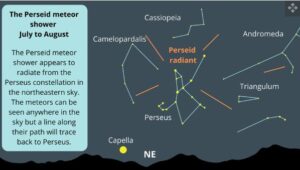The Perseid meteor shower is one of the best shooting star displays of the year and should give us a show Aug.11-12.
The next Perseid meteor shower peaks around the night of Aug. 11 and before dawn on Aug.12, 2024, with good viewing conditions for a few days on either side of the peak.

To find the Perseid meteor shower, it’s a good idea to look for the point in the sky where they appear to originate from, this is known as the radiant. According to NASA, the Perseids’ radiant is in the Perseus constellation. Though Perseus isn’t the easiest to find, it conveniently follows the brighter and more distinctive constellation Cassiopeia across the night sky. The meteor shower gets its name from the constellation it radiates from, the constellation is not the source of the meteors.
The Perseid meteor shower, commonly known as the Perseids, is visible annually from mid-July to late August. Although the moon will be 50% illuminated during the peak of the Perseids this year, it will set around midnight, providing dark skies until dawn — ideal for meteor watching!
The Perseids result from Earth passing through debris — bits of ice and rock — left behind by comet Swift-Tuttle which last passed close to Earth in 1992.
Swift-Tuttle was discovered independently by two astronomers, Lewis Swift and Horace Tuttle, in 1862. When it last made a pass by Earth in 1992, it was too faint to be seen with the naked eye. The next pass, in 2126, could make it a naked-eye comet similar in brightness to the 1997 Hale-Bopp comet — providing that predictions are correct.
Comet Swift-Tuttle is the largest object known to repeatedly pass by Earth; its nucleus is about 16 miles (26 kilometers) wide. It last passed near Earth during its orbit around the sun in 1992, and the next time will be in 2126.
The shower peaks around Aug. 11-12, when Earth travels through the densest and dustiest part of this debris. In years without moonlight, the meteor rate appears higher, and during outburst years (such as 2016), the rate can reach 150-200 meteors per hour.
According to NASA, you can expect to see an average of up to 100 meteors per hour during the Perseid’s peak.
A typical Perseid meteoroid (which is what they’re called while in space) moves at 133,200 mph (214,365 kph) when it hits the Earth’s atmosphere (and then it is called a meteor). Most of the Perseids are tiny, about the size of a sand grain. Almost none of the fragments hit the ground, but if one does, it’s called a meteorite.
The Perseids are hot stuff, reaching temperatures of more than 3,000 degrees Fahrenheit (1,650 Celsius) as each fragment travels through the atmosphere and both compresses and heats the air in front of it. Most of the fragments are visible when they are about 60 miles (97 kilometers) from the ground.
When you sit back to watch a meteor shower, you’re actually seeing the pieces of comet debris heat up as they enter the atmosphere and burn up in a bright burst of light, streaking a vivid path across the sky as they travel at 37 miles (59 kilometers) per second, according to NASA.

